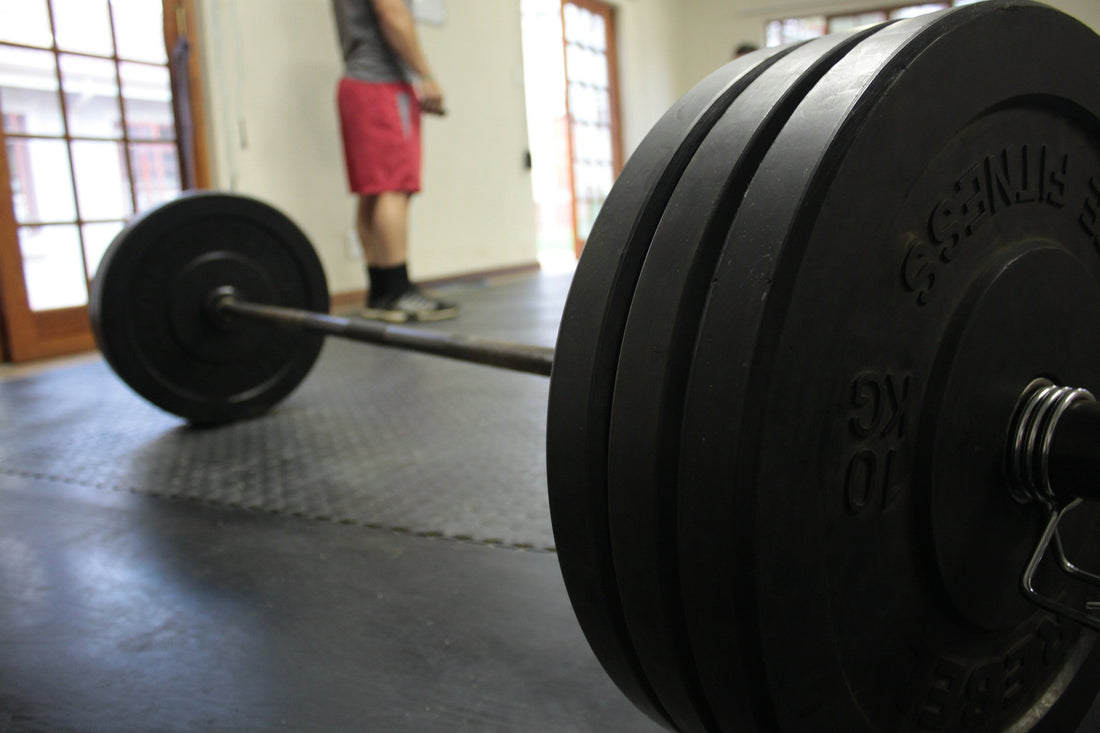When clients ask me the best exercises for muscle growth, deadlifts are always at the top of the list. Not only do deadlifts improve size, they increase testosterone, build strength and effectively shape the body towards a more muscular physique.
But unlike other compound movements like chest press, deadlifts require more practice and more attention to form or you'll injure yourself, especially when starting out and trying to hit new personal bests.
Deadlift beginners will often start seeing and feel significant changes in the quads, hamstrings and calves within the first 4 weeks while also finding improved lower back strength.

By the end of this deadlifts guide, you're going to find out how to deadlifts with proper form, as well as the plethora of benefits that deadlifts provide.
Ready?
Let's start the deadlifts guide.
What are deadlifts?
Firstly, what exactly IS a deadlift?
Deadlifts are a compound movement that involves lifting weights from the floor to your hip using your lower back, hamstrings and quadriceps to move the weight. Almost all variations require maintaining the weight as close to your lower body as possible throughout the movement.
Deadlifts typically require more practice to get the perfect deadlift form and injuries can easily result from poor form.
Deadlifts work the legs, back, forearms, abs, traps, and shoulders. The sheer number of muscles being used in deadlifts makes them an ideal movement for muscle growth and building a more muscular physique.
The type of deadlift variation will vary what primary muscle (agonist) is being used while the supporting muscles remain largely the same.
Some of the most common variations:
- Conventional Deadlifts
- Romanian Deadlifts
- Stiff Legged Deadlifts
- Snatch Deadlifts
- Rack Pull Deadlifts
- Sumo Deadlifts
Additionally, there are different deadlift grips that can be used:
- Double overhand grip
- Alterate grip
- Hook Grip
We'll talk about how to perform these variations soon, but first let's drill down into what specific muscles deadlifts work.
What Muscles Do Deadlifts Work?
Deadlifts work the following muscle groups:- Gluteus Maximus
- Quadriceps
- Adductor Magnus
- Soleus
- Hamstrings
- Gastrocnemius
- Erector Spinae
- Trapezius, Middle
- Trapezius, Upper
- Levator Scapulae
- Rhomboids
- Rectus Abdominis
- Obliques
For more detail, click the image below:

What Muscles Do Deadlifts Work? Click the image to see more detail.
Why aren't deadlifts more popular?
Most people I talk to don't like deadlifts.
For good reason. They're hard.
And getting the proper deadlift form takes practice.
While mastering other exercises like the bench press or dumbell flys is pretty easy, it takes some time to get used to deadlifts. Then you need to factor in that a LOT of people who are already doing deadlifts are using incorrect form and may not have the inclination to change.
Let's talk about the perfect deadlift form and what deadlifts should look like.
The Perfect Deadlift Form
Here is the perfect deadlift form:- Start up standing over the barbell - making sure that your feet are shoulder width apart; the barbell should be positioned just by the bridge of your feet. Feet should face slightly out to help stabilise the weight.
- When you're ready, slowly bend down and grasp the bar with your hands; your arms should be touching the outside of each of your legs.
- Next comes the complicated part: push your hips back and keep your back as straight as you can; your knees will need to be bent. Now, keeping the bar as close to your legs as you straighten your body, push with your legs. Again, you shouldn't be arching your back at all.
- Once you've straightened your body, you'll need to perform the movement in reverse; this time, lower the weight slowly into its original position, using a well-controlled movement.
See how they are performed by Strong Lift Wear founder Andrew Coleman:
Although there are different variations and grips to the deadlift, this is the basic perfect deadlift form. Once the barbell is in the original position, repeat the movement for the desired number of reps.
Take a short break and get started with the second set.

Image: Deadlift Starting Position
Tip: When you're trying these for the first time, ask a member of staff at your gym to help you or book a personal trainer to help you get the form right. Always start with just bodyweight at first to get used to the movement. Then incorporate the barbell, then add appropriate weights.
Deadlift Variations
There are various types of grips and variations when performing a deadlift. These are the ones that you NEED to know...
Deadlift Variation 1: Traditional Deadlift
This is the most common type of deadlift, and the one that we described above. It's all about keeping your movement controlled and taking your time to lift up the barbell and place it back down in its original position. Think you've mastered this one? Good! Let' move on...
Deadlift Variation 2: Snatch Grip Deadlift
This variation uses on a much wider grip when lifting the barbell, which will see you starting and finishing in a much lower position than the Traditional Deadlift. The benefits? Increased range of motion and targets the hamstrings and back much more than other types of deadlift variation. Not something for beginners, but this is a modification that you'll want to incorporate into your workout as you become more confident with deadlifting.Deadlift Variation 3: Sumo Deadlift
Unlike the Snatch Grip, the Sumo significantly decreases the range of motion so you can perform with heavier weights than other types of deadlift variation. You'll need a mixed grip for this one and will need to ensure that your feet are wide apart (even more spaced apart than in the Traditional Deadlift). You'll also notice that this exercise targets the hips and glutes more - something to think about if you want to make your training a little more varied.Deadlift Variations: Grips
As well as different variations, there's more than just the standard grip when you're performing a deadlift. In fact, choosing the right grip will allow you to control the amount of weight you use, and ensure your deadlifts are much more comfortable. The most common deadlift grip? The Double Overhand and Mixed Grip.

Image: Deadlift Grips
Beginners favor the Double Overhand (basically when both palms face downwards on the barbell, with the hands forming a tight grip), but the Mixed Grip usually provides you with more strength. For this to work, place one hand facing you and one hand facing away to prevent the barbell from slipping.
Finally, the Hook Grip is where your thumb is locked under your fingers, creating a 'hook' between the middle and index fingers - a technique that can provide you with more grip when lifting heavy, which becomes quintessential as you start reaching new personal bests.
Tip: As you lift heavy, you will likely notice that your wrists want to give way before your back or quads. This is where it's important to either use the alternate (mixed grip) or use straps to support your wrists. When I began using straps I was able to lift significantly heavier, around 10% more.
Deadlift Benefits
Few exercises can rival the benefits that deadlifts offer if your goal is muscle growth and building all round muscle mass. This makes them an excellent beginner exercise and ideal for individuals seeking a more muscular physique. Here are 8 deadlift benefits:Benefit 1: Improved Posture
As deadlifts can help to build core strength and improve the stability of the body, it can benefit your posture for the better. Slouching at work? In front of the TV? Deadlifts can help to keep your back straight and have many health benefits on the body. You probably can't same the same for dumbbell curls, can you?Benefit 2: Burns Fat Fast
Yes, that's right - deadlifts could help you to burn fat. That sounds like a win-win to us! Just like with other compound movements, weight training can be more efficient if you are trying to lose fat than just cardio and healthy eating together. So if you want to beat the bulge and increase vascularity, head down to the gym and see for yourself!Benefit 3: You don't need loads of equipment
With deadlifts, you don't need loads of expensive equipment for this exercise. In fact, you just need a bar and some weights to get started. Although many people think that the deadlift is a complicated exercise only advanced bodybuilders do, that couldn't be further from the truth. In fact, with a little practice, you could master the deadlift in just a few training sessions. Give it a try!Benefit 4: Work multiple muscles simultaneously
Instead of isolate exercises - that only focus on one muscle group at a time - compound movements like the deadlift target several different muscle groups at once, saving you a lot of time and hassle at the gym. The deadlift works everything from the butt to the back, the shoulders to the arms. And we think that's mighty impressive!Benefit 5: Improves Overall Strength
Deadlifts are all about strength; so much so, that you should notice a change in how much you can lift in other exercises. Deadlifts can make you stronger, improve the number of sets you can handle during a training session, and increase the amount of heavy weight you can lift. This makes deadlifts an excellent beginner exercise and one that should be incorporated into your training program as soon as possible.Benefit 6: Increases Testosterone
Lifting with heavy weights when performing the deadlift can increase the amount of testosterone in your body, which can help to repair the muscles and increase growth. Simply put: if you want to build healthy muscle, then deadlifts are an excellent way to go about it.Benefit 7: Improve Bone Strength
Because they provide load to the joints, deadlifts can reduce the chances of bone fracture and can improve bone strength.Benefit 8: Improves Core Strength
When lifting deadlifts, you should be using your core which will strengthen your core muscles.
Tip: Performing deadlifts 2-3 times per week over a period of 4 weeks can significantly condition and tone your midsection fast.
Deadlift Tips
Here's a few tips for deadlift beginners. And those who've been doing them for a while. Deadlift Tip 1: The number of times you deadlift at the gym is especially important if you want to see gains. This is not an exercise that you should be doing every day (you probably won't have the energy for that if you're lifting heavy), but at the same time, you don't want to go several weeks without doing it either. Generally start with deadlifts once per week, increasing to 2-3 times per week depending on your goals and your split.- Click here for a custom workout plan for your goals.
Deadlift Tip 2: Once you've decided to deadlift, put in the effort. Psyche yourself up on the way to the gym on deadlift day and know what you're doing.

Deadlift Tip 3: The amount of weight you use is crucial to your muscle building program. But when is too heavy just too heavy?! Remember - take it slow at first and avoid super-heavy weights that could potentially cause you an injury. There's plenty of time to progress as you master this exercise, but at the beginning, try and keep it easy and focus on technique. This is where a personal trainer can help you get the technique right in a short amount of time as well as to hit new personal bests.
Deadlift Tip 4: What you eat after your workouts is just as important as all the effort you've put in at the gym. In fact, it might be even MORE important. For your muscles to grow, you need protein - and lots of it! Whether that's lean meats like chicken or turkey, fish like tuna or mackerel, egg whites, nuts, or protein supplements, you'll need to up your protein intake if you want to see results. Looking to pack on some serious bulk? You'll need to eat at a calorie surplus (basically, you're going to be eating MORE than the usual number of calories your body needs to maintain its weight). If in doubt, devise a healthy eating plan that fits your macros or get a custom meal plan here.
Deadlift Tip 5: Before a heavy deadlifting session, make sure you've provided your body with the energy it needs to perform at maximum capability. A good pre-workout snack with plenty of healthy carbs can go a long way - providing you with mental clarity and focus in the gym. You might notice that you have more energy to perform that last rep or go heavier with your weight. But that's not all. Making sure you consume plenty of protein post-workout can also be beneficial - especially because it can help your muscles to repair and grow.
- Click here to see a review of popular post-workout supplement.
Deadlift Tip 6: Take a pre workout supplement. If there's one exercise you want the added strength and focus, it's deadlifts.
Common Mistakes When Performing Deadlifts
Before you start performing deadlifts, there are some mistakes that you need to avoid, so you don't hinder all those quality muscle gains. Everything on this list is a big no-no, any questions feel free to leave a comment below.
Deadlift Mistake 1: Arching your back: This is important. Never arch your back - you want to keep it straight during the entire exercise. Not only will this prevent an injury from occurring, but keeping your back straight will help you work on your form. A good thing to remember is this: try and keep your stomach tight during the exercise. Keeping your chest out and head held high will also help you to keep your back straight.
Deadlift Mistake 2: The bar: You should keep the bar as close to you as you can. If the bar's too far, your form's going to start getting dodgy, so keep control at all times! Yes, you might not be perfect at deadlifting from your very first workout, but with a little bit of practice, you should be well on your way. As you bring the bar past your knees, don't pull it up with your back either!
Deadlift Mistake 3: Unable to focus on your deadlifts? Don't get despondent. Although this exercise might be difficult at first, you'll soon get used to it so don't give up just yet! Coming up with a training plan - where you effectively log what exercises you're going to be doing at the gym and on what days - can give you the focus that you need. Alternatively, devise a workout playlist that will help you to get in the zone during your training and spur you on.
Deadlifts: Start Today
Never been interested in deadlifts?
Rethink that.
Deadlifts will improve your strength, build size and help achieve a well rounded muscular physique.
But that's not all.
Deadlifts also help with weight loss, conditioning, improving bone strength and increasing testosterone.
While getting the perfect deadlift form takes time by yourself, experienced professionals such as personal trainers will be able to help you shortcut the learning curve and start benefiting from the exercise faster.
Start incorporating deadlifts into your workouts - they are one of the best compound exercises for improving size, muscle and strength.




